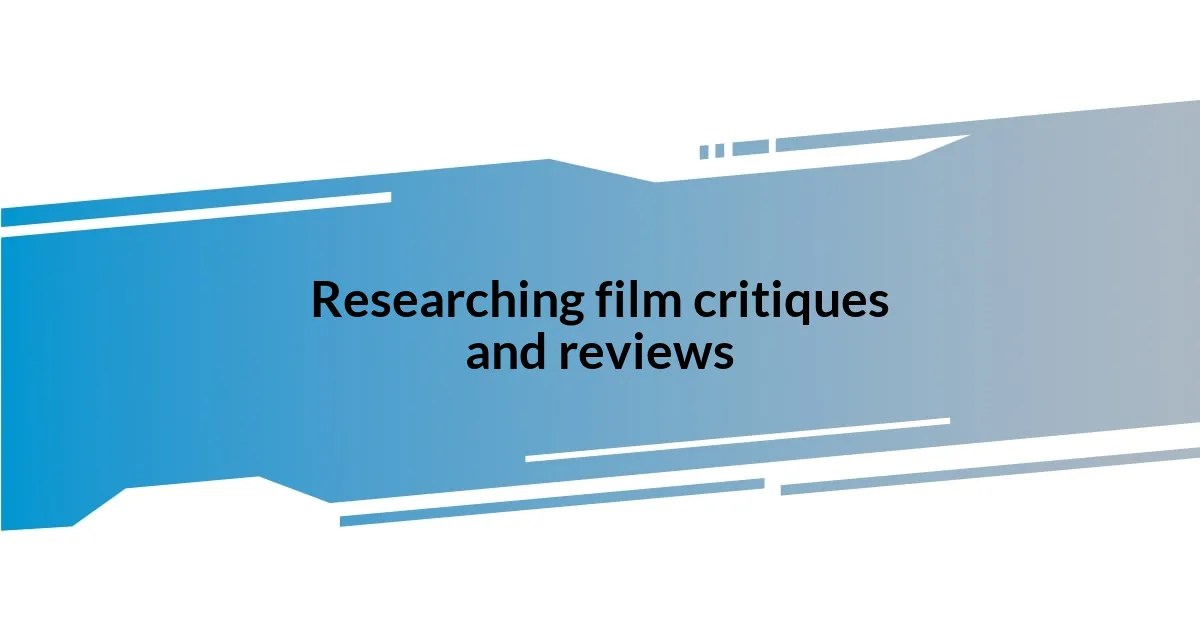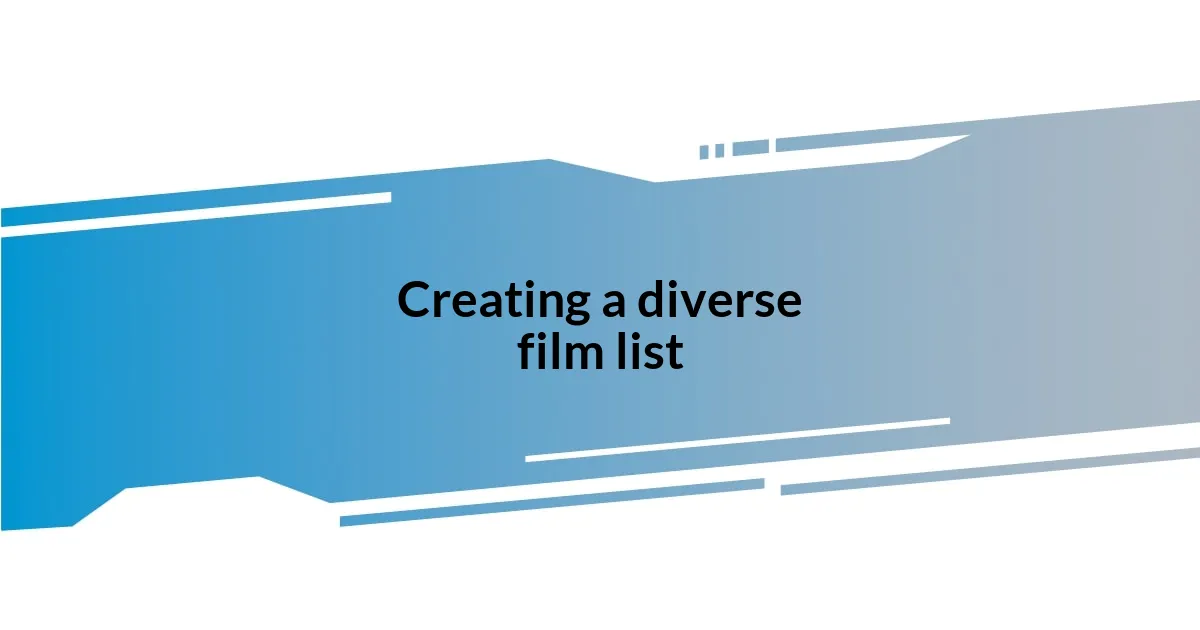Key takeaways:
- Personal film influences are shaped by individual experiences, emotions, and cultural contexts, often reflecting our own life journeys.
- Engaging with diverse genres and filmmakers enriches one’s cinematic experience, introducing new emotional responses and perspectives.
- Regularly updating film influences through exploration, re-evaluation of classics, and community discussions enhances understanding and appreciation of cinema.

Understanding personal film influences
Understanding personal film influences goes beyond the surface of just liking a genre or a favorite actor. For me, it’s about the stories that resonate with my experiences and emotions. I often find myself drawn to films that mirror moments in my life, sparking feelings of nostalgia or inspiration.
I remember watching “The Pursuit of Happyness” during a tough time in my career. The sheer determination and resilience of the main character struck a chord, reminding me of my own struggles and triumphs. Have you ever felt a film reflected your reality so vividly that it left you contemplating your own journey? I think it’s this deep connection that shapes our cinematic preferences.
Moreover, I believe our influences are shaped by cultural and social contexts. As a child, family movie nights with classics like “The Wizard of Oz” created lasting impressions. How do the films from your early years shape your tastes today? They often lay the groundwork for the narratives we cherish, influencing not just what we watch but how we perceive the world around us.

Identifying key film genres
Identifying key film genres can significantly transform how I choose films that resonate with me. I’ve always found that my emotional landscape aligns closely with certain genres. Whenever I’m in the mood for a thrill, I lean towards action movies, which often inject a rush of adrenaline that mirrors my excitement about life. On the other hand, I find comfort in dramas, where the intricate storytelling often reflects the complexities of human relationships that I’ve experienced firsthand.
Sometimes, I enjoy exploring different genres to see how they can evoke various feelings within me. For instance, the whimsical nature of animated films has a special charm; films like “Spirited Away” transport me to a realm of imagination. It’s fascinating how one genre can reclaim memories while another sparks joy or reflection. Have you ever found yourself unexpectedly moved by a genre you wouldn’t typically watch? It reminds me of the diverse spectrum of emotions that cinema can evoke, shaping our experiences in profound ways.
To streamline my selections, I often create a mental table that compares genres based on my emotional response and storytelling styles. Here’s a quick look at how I categorize my preferences:
| Genre | Emotional Response |
|---|---|
| Action | Adrenaline, Excitement |
| Drama | Reflection, Empathy |
| Comedy | Laughter, Joy |
| Animation | Nostalgia, Wonder |
| Horror | Fear, Thrill |

Exploring influential filmmakers
Exploring influential filmmakers has always been an essential part of my cinematic journey. I often find that certain directors resonate with me on a deeper level. For example, watching a film by Quentin Tarantino usually prompts me to pay close attention to dialogue and character development. His unique storytelling style and unconventional narratives challenge me to think differently about the art of filmmaking.
When I think of influential filmmakers, several names come to mind. Here’s a quick list of those who have significantly impacted my perspective:
- Martin Scorsese: His ability to delve into the human psyche in films like “Taxi Driver” fascinates me.
- Alfonso Cuarón: The visual storytelling in “Gravity” left me in awe of how cinematography can transform an experience.
- Greta Gerwig: I admire her fresh take on storytelling, especially in “Lady Bird,” which beautifully captures the essence of growing up.
- Hayao Miyazaki: His animated masterpieces are filled with enchanting worlds that inspire my imagination.
- Christopher Nolan: His intricate plots, seen in “Inception,” provoke me to think about reality and dreams in new ways.
Each of these filmmakers brings something unique to the table, and their styles often influence what I choose to watch next.

Analyzing impactful film scenes
One of the most striking aspects of my film-watching experience is how certain scenes linger in my mind long after the credits roll. For instance, I still vividly recall the emotional crescendo in “The Pursuit of Happyness,” where Will Smith’s character finally secures a job. That moment encapsulated hope amidst struggle, and I can feel the weight of those emotions even now. Why do we find ourselves drawn to these pivotal scenes? Perhaps it’s because they speak to universal truths about perseverance and resilience.
I often analyze scenes not just for their content but for their emotional texture. Take the quiet yet powerful ending of “Her,” for example. The way Joaquin Phoenix’s character grapples with love and loss resonates deeply with me. I can relate to the feeling of yearning for something that’s just out of reach. Analyzing such moments helps me connect my own experiences to the characters’ journeys, making the viewing experience more intimate and personal.
Sometimes, I even keep a mental catalog of these impactful scenes, jotting down specific quotes or visual motifs that strike a chord. This practice helps me reflect on why certain films make a lasting impression. Have you ever paused a film just to absorb a beautifully crafted scene? The meticulous attention to detail in cinematography can transform a fleeting moment into a profound experience that stays with you. I find myself revisiting those scenes in my mind, pondering how they shape my understanding of love, loss, and everything in between.

Researching film critiques and reviews
Researching film critiques and reviews is a fascinating journey that can significantly shape my viewing experiences. When I dig into thoughtful critiques, I often discover layers in films that I hadn’t initially noticed. For example, a keen observation about a director’s choice of color palette can completely alter my perception of a scene. Have you ever felt that the mood of a film shifted for you just because of a critic’s insight?
I enjoy exploring different perspectives in film reviews, which often present unique interpretations that resonate with my feelings or challenge my viewpoints. Recently, I read an account of how a film’s score ties into its narrative arc, and it made me revisit the movie with fresh ears. It was illuminating to realize how the music subtly shaped my emotional response, and I found myself listening more closely to the soundtrack on my next viewing. Isn’t it intriguing to think about how many components work together to create a memorable cinematic experience?
Diving into discussions about films on platforms like Letterboxd or reading blogs from passionate cinephiles allows me to engage with a community of fellow movie lovers. The varied opinions often spark new ideas for what I might watch next or encourage me to delve into a debate about a film’s themes. I can still recall a lively discussion I had about the ending of “Inception,” where people shared their theories, enriching my understanding and appreciation of the film. Isn’t it wonderful how engaging with others’ perspectives can deepen your connection to cinema?

Creating a diverse film list
Creating a diverse film list is vital for enriching my cinematic experience. I focus on movies from different cultures, genres, and perspectives. Recently, I watched an acclaimed South Korean film that challenged my views on societal norms. It made me reflect on how cultural contexts shape narratives in profound ways. Have you ever watched a film from a different country and found yourself questioning your own beliefs?
I also love mixing genres; it keeps my viewing life exciting. I might watch a thought-provoking documentary followed by a light-hearted romantic comedy. This variety not only entertains me but also helps me appreciate filmmaking techniques across different styles. One evening, after watching a gripping thriller, I found it refreshing to dive into a whimsical animated feature that reminded me of my childhood. It’s like a deliciously diverse meal for the mind!
Curating my list with attention to different voices and stories makes each film feel significant. I often seek out films created by women, LGBTQ+ filmmakers, or those from diverse racial backgrounds. Last summer, I discovered a powerful indie film about a young queer artist navigating family acceptance, and the emotional depth of that story lingered with me for days. What if we all made an effort to include more varied films in our lists? It could open up a world of understanding and connection that we didn’t even know existed.

Regularly updating film influences
Regularly updating my film influences is crucial. I make it a habit to check what’s new in cinema every month. Recently, I stumbled upon a documentary exploring the evolution of animation. It was fascinating to see how different techniques shaped storytelling over decades. I found myself mesmerized by the artistry behind every frame. Have you ever watched a film and felt it transformed your understanding of a genre?
I also enjoy revisiting classics but with fresh eyes, often influenced by contemporary reviews or discussions. A few weeks ago, I watched a beloved film from my childhood and realized how my interpretations had shifted. The themes that once seemed simplistic now resonated deeply, revealing complexities I had missed at a younger age. It’s amazing how our perspectives can evolve, isn’t it?
Engaging with film festivals or online events has become a delightful way to discover new influences. I attended a virtual screening last month that showcased up-and-coming filmmakers, and it opened my eyes to perspectives I hadn’t considered. These emerging voices add richness to my film repertoire. It sparks a simple yet powerful question: what films might I be missing that could ignite a new passion within me?
